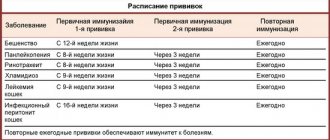In this article, we have collected the official rules: what documents and vaccinations a pet needs before flying, where to get them, what animals can and cannot be transported on airplanes.
Click to go to the desired section:
- What documents and vaccinations are needed to take a pet out of Russia?
- Which animals need permission from Rosselkhoznadzor for export and import and how to obtain it
- How to import an animal to Europe and other countries (with a self-test checklist)
- How to bring an animal to Russia
- Do I need to declare dogs, cats and other animals?
- What is a CITES permit and who needs to get one?
- What documents are needed to fly within Russia?
- Which animals are prohibited from being transported on airplanes and what to do if yours is one of them
- Is it possible to transport puppies and kittens by plane - in Russia and abroad?
How to take a pet abroad
Before flying abroad, you need to take into account the rules of two countries: the point of export and the point of entry.
If the journey begins in Russia, first check how to properly export an animal from our country and what is required for import into another.
To return with a pet from abroad to your homeland, find out the rules in reverse order: how to take a pet from another country and bring it to Russia.
What should I bring?
The right container is also important, especially if the trip is planned in the luggage compartment. It must be durable, ventilated and spacious enough for the animal to move around. For a cabin flight, it is better to choose a soft, compact carrier that can be stored under the seat. Your pet needs to be accustomed to a temporary home in advance: put treats inside, praise if he settles in it on his own.
The carriage also needs to be prepared for the flight: check the fastenings, remove or fix the wheels. It is better to lay absorbent napkins on the bottom, and on top - a blanket or any other bedding familiar to the pet. You can put your favorite toy there to brighten up the loneliness during the flight. Be sure to put a sticker on the container for movers: write live animal on it and indicate the bottom and top with arrows.
Export of animals from Russia
Dogs and cats
You can export your pet dogs and cats
Documents needed:
1) International veterinary passport , which contains notes on microchipping, vaccinations and deworming treatment. You can get a veterinary passport at the veterinary clinic at the same time as microchipping or vaccinations.
• Microchip implantation . Identification of an animal using a microchip is optional in Russia, but microchipping is required to enter most other countries. Microchipping must be done strictly before rabies vaccination, otherwise the animal will not be allowed into Europe. The process is quick and painless: a capsule the size of a grain of rice is inserted into the pet’s withers. A sticker with a barcode and a 15-digit microchip code is pasted into the veterinary passport, and information about the animal is entered into the database.
For most countries, the chip must comply with the ISO 11784 / 11785 standard. If your destination country has a different standard, you will need to carry a suitable scanner with you to read it.
According to European rules, a stamp is also suitable for identification - but only if they were made before July 3, 2011 and are legible. In this case, the animal does not need to be chipped.
• Rabies vaccination : If your pet has not been vaccinated against rabies within the last 12 months, then the vaccination must be done no later than 20 days before the date of border crossing. Please note that the host country may have different rules: in the EU, for example, it is 21 days after the initial vaccination. Choose a vaccine that is recognized in the desired country, for example, Nobivac. Without a rabies vaccination, it will not be possible to take an animal abroad.
In addition to vaccination against rabies, dogs need vaccinations against distemper, hepatitis, viral enteritis, parvo- and adenovirus infections, leptospirosis; cats - from panleukopenia. Stickers about each vaccination with the date, signature and stamp of the doctor are placed in the veterinary passport.
Both dogs and cats must be treated for worms. Animals may require different vaccinations and treatments to enter another country.
2) Veterinary certificate form No. 1 . You need to get it from a state veterinary clinic within 5 days before your trip. Here is a list of suitable clinics in Moscow and St. Petersburg.
What is needed to obtain a veterinary certificate for a cat or dog :
- veterinary passport with chipping and vaccination records,
- results of stool analysis for helminths. If the passport contains a note about deworming, certified by a doctor’s seal, then theoretically no analysis is required,
- clinical examination, during which the doctor will confirm that the animal is healthy,
- for cats: fluorescent diagnostics is when the animal’s skin, fur and claws are examined under the light of a Wood’s lamp to check for lichen and other fungal diseases.
Certificate No. 1 is valid for 5 days , that is, you must fly within this time. It is worth contacting the veterinary station in advance, so that it does not turn out that additional vaccinations or treatments are needed to issue a piece of paper, and you no longer have time.
Before departure, at the airport veterinary service, certificate No. 1 will be exchanged for veterinary certificate form No. 5a. If you are flying to Europe, you will also be given an EU veterinary certificate (European certificate). Certificate 5a is not asked for abroad; it is needed to return home. A European certificate is needed to enter Europe. To speed up the process yourself, and only assure at the airport. Just in case, take several copies, including blank ones.
If you are flying to Belarus, Armenia, Kazakhstan or Kyrgyzstan , then instead of certificate form No. 1, receive a veterinary certificate of the Customs Union (form No. 1). There is no need to change it before departure.
If a dog or cat is traveling without an owner or you are going to sell them abroad , you still need a permit for export.
A certificate from the RKF stating that the dog has no breeding value is not needed either for issuing certificate Form No. 1 or for the flight.
Everything except dogs and cats
Other animals (rodents, birds, invertebrates and others) are exported with permission from Rosselkhoznadzor, except if you are traveling to Belarus, Armenia, Kazakhstan or Kyrgyzstan. Otherwise, the removal scheme is the same as for dogs and cats.
That is, for all pets, excluding dogs and cats, the following documents will be required:
- veterinary passport. In addition to animals for which they are not issued either in Russia or in the country of entry - for example, hamsters and guinea pigs,
- veterinary certificate form No. 1,
- permission.
In this case, it is imperative to comply with the veterinary requirements of both countries and marks about this must appear in the documents. For example, in Russia, birds will require vaccination against avian influenza or the result of an avian influenza test, as well as tests for psittacosis and salmonellosis. You can find out exactly the Russian requirements for exporting your pet when you apply for a certificate at the state veterinary station, and they will also be written in the permit.
If your animal is rare and its species is endangered, to transport it, in addition to the veterinary passport and Form 1 certificate, you may need a CITES permit.
Before the flight
The animal must be presented clean and tidy at registration so that there is no suspicion of non-compliance with sanitary standards. You should not give your pet water 5-6 hours before the flight. Sleeping pills and tranquilizers should also not be given, especially without consulting a veterinarian - at altitude they can cause breathing problems and heart function. If the flight is long, then a supply of water and food will be required; during the flight, all this must be given to the animal “with you” in the luggage compartment.
You can consult a veterinarian regarding antidepressants - animals have a hard time surviving the flight, special medications can alleviate their condition.
When going on a flight with an animal, it is better to arrive at the airport 5 hours in advance. You will need to visit the border veterinary control point and exchange certificate No. 1 for a certificate of international form 5A, valid for 1 day. You can make an appointment at this point in advance; phone numbers are available at the office. website of the Federal Service for Veterinary and Phytosanitary Supervision.
When checking in with your pet, it will need to be weighed at the check-in counter, so you won't be able to check in online. The excess amount of “living luggage” costs more, usually twice as much. For long transfers, you may be charged an additional fee for service during connections.
Permission from Rosselkhoznadzor
You need permission from Rosselkhoznadzor if:
- you bring more than two dogs or cats to Russia;
- you import into Russia up to five pieces of any other animals, except cats and dogs;
- you export animals other than dogs or cats from Russia in any quantity.
There are two types of permission from Rosselkhoznadzor for the import and export of animals:
1) A “general” veterinary permit in form No. 1 is issued once a year and is valid for everyone. Check on the Rosselkhoznadzor website to see if your country of entry/exit and your animal are on the list. If found, then you do not need to obtain individual permission.
For example, in 2022, with a general permit, you can import from Greece to Russia from 3 to 5 dogs or up to five guinea pigs, canaries, meerkats or rats (there are more permitted animals, we give some as an example).
2) An individual permit is needed if a general permit has not been issued for your pet. An individual veterinary permit is made in the Argus veterinary electronic system.
First you need to gain access to the system. Send a telegram and in a few days you will receive your login and password by email. Or obtain your login information in person from the veterinary department.
Then fill out an application to import or export an animal, wait for it to be approved, and print out the permit. If you are exporting an animal from Russia temporarily and plan to return, then in the “Purpose” column indicate “For non-commercial use with return import/export.” If you plan to travel several times, indicate in your application the number of animals according to the number of trips: customs officers will deduct one each time. The permit is valid for the entire calendar year.
Importing an animal into another country
In addition to the rules of your country for exporting an animal, you must fulfill the veterinary requirements of the country of entry. Animals are usually not allowed on connecting flights, but if you do, and you leave the transit zone at an intermediate airport, you will also have to comply with the requirements of the third country.
You can find out exactly the veterinary requirements for import at the consulate or official veterinary authority of the desired country. Rules for dogs and cats are usually published on the website; for others you will have to check by email. Be sure to indicate which country you are entering from - requirements for importing from different countries differ. To get your bearings, you can first look at the requirements on the Pettravel.com website, but then be sure to double-check the data from official sources.
Checklist of what to pay attention to when exporting an animal abroad:
• Is it possible to import an animal? Domestic cats, dogs and ferrets are allowed into most countries in the world. But there are exceptions. For example, ferrets will not be allowed into California, Washington, Hawaii and New Zealand, where they are prohibited. Many places, including the UAE, Singapore, Denmark and Spain, prohibit entry for dangerous breeds of dogs: pit bull terriers, Tosa Inu, Dogo Argentino, American Staffordshire terriers, Neapolitan mastiffs, Brazilian Fila and others.
Birds, fish, snakes, rodents and turtles are usually imported with additional documents - including CITES permits.
It happens that animals can only be imported from certain countries, as in Australia, only through certain airports and border crossings, or only on licensed airlines, as in the UK.
• Does the animal need to be microchipped? As a rule, it is necessary, but the current rules should be clarified.
A rabbit is given a microchip
• How many animals can you take with you? The number of pets allowed for import depends on the country of entry. Norway allows five cats per person, but China only allows one.
• What vaccinations, treatments and tests do pets need to fly ? The most important vaccination is against rabies. To enter Europe, the first rabies vaccination must be given after microchipping, but no later than 21 days before departure. There is no need to wait 21 days after a second vaccination, provided that it was administered when the previous one has not yet expired.
A bunch of countries, including all European ones, require testing for rabies antibodies for dogs, cats and ferrets if the animal comes from countries that are unaffected by this disease or from places where there is not enough statistical data on the topic. Russia is not one of these, therefore, when traveling from our country to Bulgaria, Spain, Finland and other EU countries, a test for rabies antibodies is not needed. This is confirmed by EU Regulation No. 577/2013 and the official response of the European Commission.
Find out the exact list of vaccinations and treatments required to enter the country. For example, 1–5 days before entering Finland, Norway and the UK, the dog must be dewormed. To travel to the UAE, the cat must be vaccinated not only against panleukopenia, but also against rhinotracheitis and calicivirosis.
Anna Kovalenko , travel organizer:
“Once in Tbilisi, someone told us that they met a young man with a camel in the city. Camel in Tbilisi?! They said that his Iranian owner had been traveling with the camel for 3 months, passed through Armenia to Georgia and was going to continue in Russia. We all laughed together, and a week later we went by bus to Vladikavkaz. How surprised we were when the story turned out to be real! We were driving through Stepantsminda and... we noticed a camel by the river. We stopped at a wigwam-type hut - and the Iranian said that he was not allowed across the border because the camel did not have some kind of permit.”
• Will the animal be quarantined? Even if all veterinary requirements are met, it happens that the animal is still quarantined. For example, when flying from Russia to Singapore, a dog faces 30 days of captivity. The rules are even stricter in New Zealand. You cannot import an animal there directly from Russia: first it must spend six months in one of the rabies-free countries, for example, Germany, and then serve at least 10 days of quarantine in New Zealand. The owner of the animal pays for quarantine.
• Do you need an import permit - like the one issued by Rosselkhoznadzor in our country? For example, to import a dog or cat into Thailand, you need to send an email to the veterinary service no later than 15 days before departure and receive permission to transport the pet within a week.
• What other documents are needed. For example, to import animals into the EU before departure (that is, still in Russia), you need to have a European certificate certified . This is both a veterinary and customs document and a mandatory condition for entry into the European Union if the animal does not have a blue EU passport, which can only be obtained in Europe: those sold in our veterinary stores are not suitable. You need to enter the EU with this certificate within 10 days, and you can travel between EU countries for 4 months from the date of issue of the certificate, provided that the rabies vaccination is valid. Read the official explanations on how to fill out the European certificate.
After arrival
If the animal was flying in the luggage compartment, then you can get it with the rest of the luggage; carriages leave first, before bags and suitcases. Then you need to find the local veterinary control and present the animal with all the documents. Further, it all depends on the country: some provide general or selective quarantine, that is, you will have to part with your pet for some time. A return flight will require permission, which is also issued by the veterinary service; it is better to immediately clarify how and when to obtain it correctly.
March 27, 2018
Importing an animal to Russia
A dog or cat can be brought from abroad to Russia with one document - an international veterinary passport, provided that the pets are traveling with their owner, there are no more than two of them and they are not intended for sale. The passport must contain information about the vaccines administered with dates and a note about a clinical examination by an official veterinarian within the previous 5 days. Animals are not quarantined.
If a cat or dog does not have a passport that meets the requirements of the Eurasian Economic Union, or you are not 100% sure that the passport is suitable (for example, you bought a pet in China and received an international passport there), then they can be imported using certificate form No. 15 . Download it and complete all necessary marks with the government veterinarian.
If you initially left Russia with the animal, then you will already have certificate No. 5a , with which you can enter the Russian Federation instead of a veterinary passport and certificate No. 15.
Certificate 5a is valid for 90 days: if you return to Russia during this time, you do not need to do any vaccinations or treatments abroad. But, according to Russian rules, before the return flight, the veterinarian must certify that there have been no outbreaks of infectious diseases in the country of your travel. Most often, such a mark can be obtained from the airport veterinary service before departure, but it is better to find out in advance - ask on the spot on the day of arrival.
How to import animals if the 5a certificate is no longer valid
If certificate 5a has expired, then dogs and cats can be brought back using a passport, provided that a clinical examination was stamped within 5 days before entry, or using certificate No. 15.
After arriving in Russia, the certificate is exchanged at the airport veterinary service for a veterinary certificate of form No. 1 or a certificate of form No. 6.1, with which you can fly or travel further across Russia. If the animal enters only with a passport, then these documents will be issued additionally.
If there are 3 to 5 cats or dogs, or they are being imported for sale, or they are traveling without an owner (for example, you sent the animals with friends), then you will need permission from Rosselkhoznadzor.
For other animals and birds, including pet rabbits, ferrets, guinea pigs, hamsters, squirrels, chipmunks, chinchillas, parrots and canaries, you will need:
- permission from Rosselkhoznadzor;
- international veterinary passport or veterinary certificate in the form of the Eurasian Economic Union . Ferrets are usually given the same passports as dogs and cats. For rodents and other non-passported animals, you need to issue a certificate by downloading the required form from the EEC list. For fur animals, rabbits, dogs and cats, form No. 15 is suitable, for wild animals - No. 16. Form No. 41 is described strangely: for zoos and circuses, but it means any animals “born and raised in captivity or kept in captivity not less than 90 days”, that is, for many animals this certificate is needed. Which certificate is suitable (more precisely, what kind of animal yours is considered to be - wild, zoo, fur-bearing or, for example, laboratory) will be written in the permit from Rosselkhoznadzor. If you are still not sure, check with Rosselkhoznadzor.
All animals must comply with the veterinary requirements of the Eurasian Economic Union.
Dogs, cats, ferrets and other animals that potentially carry rabies must be vaccinated against the disease within the last 12 months, but no later than 20 days before travel. Dogs - also from canine distemper, hepatitis, viral enteritis, parvo- and adenovirus infections and leptospirosis; cats - from panleukopenia; minks and ferrets - from canine distemper, viral enteritis and pasteurellosis; rabbits - from myxomatosis, pasteurellosis and viral hemorrhagic disease.
You will read in the permit from Rosselkhoznadzor what other animals need to be treated and vaccinated against and whether they will have to be quarantined.
For example, fish and invertebrates (snails, spiders, crayfish and scorpions) can be imported into Russia only after quarantine for at least 30 days and examination by a veterinarian within 72 hours before travel.
wild animals are identified (that is, microchipped, ringed or tattooed) and quarantined for at least a month, during which they are tested for diseases depending on the type of animal. For an exact list of tests and vaccinations and other requirements, see the document of the Eurasian Economic Commission.
What do you need to know when preparing for your trip?
Many holders of a residence permit in Europe or a second citizenship spend quite a lot of time in the EU and at the same time do not want to part with their pets. In fact, any dog or cat may not be able to bear being separated from its owner for several weeks or even months. The only way out is to take them with you. In addition, individuals regularly participate in international animal shows.
If you comply with all the conditions of the EU directives regarding the import of animals, then no problems will arise. By the way, it is useful to study the information on the official website of the European Union and familiarize yourself with the Rules for the transportation of pets. However, it should be remembered that individual European countries have special conditions that you also need to be aware of.
In addition, if an outbreak of a virus or infection occurs in one of the countries, the rules may be tightened up to the complete suppression of the movement of animals into the EU. You will have to come to terms with these demands; they are temporary.
Important! In the EU, there are regulations of the European Parliament, the Council of the EU and the European Commission 576/2013 and 577/577 for the transport of pets, which came into force on December 29, 2014. There is no tax on the import of pets for temporary stay in the EU.
Do I need to declare my pet?
Most countries require dogs, cats and other pets to be declared. This must be done both at the exit and at the entrance. The owner of the animal passes through the red corridor and presents a customs declaration. To save time, you can fill it out in advance.
To leave Russia, you need a customs declaration, the form of which is available on the website of the Federal Customs Service. After all the formalities, one copy of the declaration will remain with you: when you return, hand it over to the customs officers along with the entry declaration. The information about the animal must match.
to enter Europe . In the red corridor, show the European certificate - this is a 2 in 1 document: both veterinary and customs.
The declaration form for entry into another country can be downloaded from the customs service website, obtained from the flight attendants during the flight or upon arrival in the red corridor. Take care of the copy that the customs officers give you: you will need it to fly out of the country.
Other nuances
- Before preparing an animal to leave the country, you need to take care of its appearance so that veterinary control at customs can be passed without any problems (clean coat, clear eyes, absence of any nasal discharge, and so on).
- You need to find out from the transportation company whether it is allowed to take a cat into the cabin, what type of carrier should be, and similar important information.
- When booking your ticket, please indicate that you are traveling with a cat. For this purpose, a special fee is paid, which is calculated based on the weight of the cat along with its carrier.
Transporting an animal from the CITES list
CITES is the convention on international trade in endangered species of wild fauna and flora. It regulates the transport of rare species of animals, plants and their parts, for example, hunting trophies. If your pet is included in the CITES Appendices, then in addition to the standard set of documents, you will need a CITES permit.
Here is the official list of all animals in Latin from the CITES Appendices. If the animal is included in the strictest Annex I, then to transport it you will need to obtain two permits: in the country of departure for export and in the country of entry for import.
Appendix II animals often only require an export permit, but it is best to check the rules of the country of entry. For example, to import into Europe you cannot do without a second permit - an import permit.
For Annex III pets you will have to obtain a certificate of origin. Regardless of the type of CITES application, additional documentation may be required in the country of entry.
Article VII of the CITES convention lists exceptions. For example, Appendix I animals bred in captivity for sale are considered Appendix II species.
To obtain a permit abroad, you must apply to the national environmental authority. In Russia, permits for the export and import of animals from CITES Appendices I or II are issued by Rosprirodnadzor. The necessary documents are listed in Order No. 47 of the Ministry of Natural Resources of the Russian Federation. You can read what is required in practice and how the procedure goes in the reviews of experienced travelers. Here are stories about how a CITES permit was obtained for a turtle and the Venezuelan Amazon.
If your animal is not included in the CITES Appendices, but it is something exotic, and not just a cat, dog or ferret, it makes sense to go to the zoo and get a certificate on the official form about the species.
What documents are needed to fly with an animal in Russia?
A veterinary passport is sufficient for dogs and cats to fly across Russia . It must contain a note about rabies vaccination (it is mandatory according to sanitary and veterinary rules), which was received no earlier than 12 months and no later than 20 days before departure. In addition, the pet must be treated for worms or there must be a test result for helminthiases obtained within a month before departure. There is no need to microchip the animal.
Just in case, call the nearest state veterinary hospital or the veterinary control of the airport from which you are going to fly, and find out if additional vaccinations, treatments and tests are needed - requirements may change due to outbreaks of infectious diseases.
Previously, to fly with a dog and a cat, you still had to obtain a veterinary certificate in Form No. 1, but paragraph 16 of the Order of the Ministry of Agriculture of December 27, 2016 abolished this requirement. At the same time, a veterinary certificate (form No. 1) is still needed if animals are taken to participate in an exhibition or if a pet is not flying with its owner.
For other animals, it is necessary to obtain a passport or veterinary certificate in Form No. 1 and, most importantly, to comply with the veterinary requirements of our country. Vaccinations, treatments and tests may be required. To find out what should be included in the accompanying document for a rabbit, canary and other pets, call the state veterinary station or the airport veterinary control.
Medical training
It will take 3-4 months to get all the necessary vaccinations and examinations and have a chip installed, so you shouldn’t put off a visit to the veterinarian. To move, you need a veterinary passport; the form can be purchased at any veterinary store. You need to paste a full-face color photo into it and fill out all the fields in English.
You need to start with deworming, the drug will be prescribed by your doctor. Vaccinations are usually given after 2-4 weeks. The most important thing is for rabies; they won’t let you go anywhere without it. It is annual, so the statute of limitations at the time of the trip is from 1 year to 30 days. Many countries, in particular the European Union, require a blood test for antibodies a month after vaccination to ensure the effectiveness of vaccination. And you can cross borders only 3 months after receiving the results.
Chipping is another important stage of preparation. This is a procedure for implanting a microcircuit with an identification number under the shoulder blade, with the help of which the owner can be found if the animal gets lost. They give you a certificate with a number and put a stamp in your passport. The chip is valid for 25 years.
Which animals can and cannot be transported on an airplane?
Typically, pet dogs and cats fly on airplanes without any problems. But some airlines prohibit the carriage of dogs with a flattened muzzle , such as pugs, bulldogs, boxers, Shih Tzus and Pekingese. Due to the structure of their nose, they can suffocate during the flight. For the same reason, cats of brachycephalic breeds with upturned noses (Burmese, Persian, exotic, Himalayan) are denied flights, but such a ban is less common.
Not all airlines allow you to take ferrets, hares, rabbits, turtles and birds with you, but you can still find a carrier. It’s much more difficult with rodents: almost no one carries them either in the cabin or in luggage. Among the rare carriers that are loyal to hamsters and guinea pigs are Finnair and Belavia. The chance of carrying reptiles, amphibians, reptiles or arthropods on an airplane is also close to zero.
The list of permitted and prohibited animals is usually clearly stated on the airline's website. For example, dogs, cats, birds (except raptors), fish and turtles will be allowed on board Vueling, and rodents, lagomorphs (for example, rabbits), mustelids (for example, ferrets), farm animals, birds of prey and reptiles will be refused carriage. If your pet is not on the list, call the airline and ask if it can be carried and under what conditions.
If the animal is on the prohibited list , all is not lost. Rodents, snakes, spiders and generally any animals that are not allowed in checked baggage or hand luggage can be sent as cargo, that is, unaccompanied baggage. This is how circuses and zoos transport animals, so you can take anyone - even a penguin, crocodile or salamander, the main thing is to prepare the documents and comply with the requirements for transportation. An example of transportation requirements can be found on the S7 cargo service website.
We are planning a flight
There are two options for transporting animals: in the luggage compartment and in the aircraft cabin. Pets weighing up to 8 kg are allowed into the cabin in a special container that can be placed under the seat in front of the passenger. One container is allowed per adult. You can put, for example, two rabbits or ferrets in it - the main thing is that the weight does not exceed the established 8 kg. An animal may not be allowed into the salon if it smells bad or behaves aggressively. If airline employees decide that four-legged animals will conflict on board, this will also be a reason for refusal, even if they belong to the same owner.
There are carriers that, as a matter of principle, do not allow animals on board, for example, Emirates.
An exception is made only for guide dogs and police dogs - they always fly in the cabin. Animals with upturned noses (pugs, Pekingese, Persian cats, etc.) due to their anatomical features can suffocate due to pressure changes, so they are transported only in the cabin. Some airlines completely refuse to transport such animals, for example, Aeroflot.
An adult traveling with an infant will not be allowed to bring a pet into the cabin.
All conditions for animals have been created in the luggage compartments: they are sealed, well heated, and the containers are fixed in rows. For large pets (45-50 kg), you will need to issue a cargo transportation contract.
Is it possible to fly with puppies and kittens - in Russia and abroad?
In law
In Russia there are strict rules. The unified veterinary requirements of the EAEU prohibit the movement, export and import of dogs and cats that have not been vaccinated against rabies. In this case, the vaccination must be done no later than 20 days before departure.
In practice, this means that if a puppy or kitten has not yet been vaccinated against rabies due to its age, then it is impossible to take it abroad, import it into Russia and other EAEU countries, or even legally move from one city to another within the country. The first vaccination is usually given at 12 weeks, then another 20 days are waited until immunity is formed - and only then can you fly. If in doubt, read the letter from the Eurasian Economic Commission and the instructions from Rosselkhoznadzor with explanations.
In the European Union, the import of puppies, kittens and ferrets without vaccination against rabies is prescribed in EU Regulation No. 576/2013 . If there are no additional rules in an EU country, then under this regulation it is allowed to import animals without a rabies vaccination at all, if they are not yet 12 weeks old. At 12–16 weeks, you can go immediately after vaccination, rather than wait another 21 days. In both cases, one of the following conditions must be met: 1) the cub travels with a mother who feeds it and who has a valid rabies vaccination received before its birth, 2) the owner or other accompanying person provides a declaration that since the moment of birth the cub has not came into contact with wild animals that carry rabies.
EU countries may impose additional rules . If you are entering not from Europe, but from a third country, then an animal without vaccination against rabies will be accepted in Estonia and Austria, but will not be allowed into the UK, Finland and Belgium.
According to airline rules
Once you are sure that the puppy or kitten can be picked up from one country and transported to another, check whether they will be accepted on board the plane. Many airlines only transport animals if they are of a certain age - usually 10-12 weeks.
Read about the rules for transporting animals in different airlines, how to prepare for a flight so that everything goes well, and what experienced dog and cat lovers advise you to take into account.
First thing
First of all, make sure that it is not easier to leave the cat at home. Here are some examples when it is better not to disturb a cat:
- The cat has nowhere to live. Imagine that you are going to visit relatives, and they are allergic to cats. It is easier to leave a cat in a hotel in your hometown than to rent out a hotel while visiting.
- Long quarantine. When crossing some borders, animals have to remain in quarantine for up to six months.
- Nervous character of the animal. Some cats are simply pathologically afraid to leave the house. Especially if they have never left the apartment, which is not uncommon now.
If your cat is an avid traveler, and the same cat lovers without a hint of allergies are waiting for you at the place of arrival, get ready for a trip. Cats have no business lying on the sofa!









